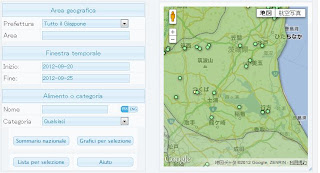Cesium In Food: Update 18 Months Later
 The Japan Times has a good piece on the food here, which is being continuously tested for radioactivity. There are some concerns about fish, chestnuts and "food sourced from forests, rivers and lakes in
the Tohoku and northern Kanto regions and from the Pacific Ocean. This
includes mushrooms, mountain vegetables, wild game, freshwater fish and
bottom fish."
The Japan Times has a good piece on the food here, which is being continuously tested for radioactivity. There are some concerns about fish, chestnuts and "food sourced from forests, rivers and lakes in
the Tohoku and northern Kanto regions and from the Pacific Ocean. This
includes mushrooms, mountain vegetables, wild game, freshwater fish and
bottom fish."The Japan Times: Cesium contamination in food appears to be on wane
However, most people do not eat any of these items, and certainly not in any great quantities. As Takashi Ishimaru, a professor of ocean sciences at Tokyo University of Marine Science and Technology, points out to The Japan Times, when waste and plankton carcasses tainted with radiation sink to the seabed, they are eaten by the bottom-feeding organisms, which in turn are eaten by bottom fish. Commercial fishing near Fukushima Prefecture has been voluntarily banned so there is little chance of getting any of this on our plates. But Ishimaru also said it will take "much, much more time" before all fish near the coast of Fukushima are free of contamination.
Official data is updated regularly at the Ministry of Health and Welfare website (E). For example, the news is that chestnuts from Tochigi Prefecture, are now restricted "for the time being" together with bamboo shoots, shiitake mushrooms, boar meat, and some other foods, according to this pdf file from September 18, 2012.
You can check the available data on a remarkable website, http://www.contaminazione-
Looking at the prefectures, only a tiny amount of foods exceed the 100 Bq/kg limit ("Action levels*") in the past six months since April 1, 2012 until September 20, 2012:
Fukushima: Foods tested: 14837 Action levels: 700
Miyagi: Foods tested: 10502 Action levels: 116
Ibaragi: Foods tested: 9322 Action levels: 93
Tochigi: Foods tested: 10371 Action levels: 165
Gunma: Foods tested: 9875 Action levels: 23
Chiba: Foods tested: 3402 Action levels: 20
Aomori: Foods tested: 1561 Action levels: 2
Iwate: Foods tested: 9167 Action levels: 229
Akita: Foods tested: 1778 Action levels: 0
Yamagata: Foods tested: 7621 Action levels: 2
Saitama: Foods tested: 2026 Action levels: 1
Tokyo: Foods tested: 354 Action levels: 3
Kanagawa: Foods tested: 930 Action levels: 2
*Action levels mean foods will not be allowed to be sold.
Source: MHLW 20Sept2012_Sum_up_since_01Apr.pdf
More importantly, independent testing is carried out in Tohoku.
The Japan Times asks:
Can we believe government data? Are there any other data that indicate contamination of food we are eating is low?
Co-op Fukushima has been examining cesium
levels in meals cooked by Fukushima Prefecture residents and the results
are showing a similar trend. Any cesium detected is usually very low,
the consumer group says.
The co-op has performed the tests two times,
with each round covering 100 households. The families prepare an
additional setting for every meal over the course of two days for
testing by the co-op. About 90 percent of the participating households
used produce from Fukushima Prefecture in their meals.
Among the 100 households tested between
November and March, radioactive cesium was detected in 10 meals. But the
highest detected amount was 11.7 becquerels per kilogram, far below the
government limit of 100 becquerels per kilogram.
Cesium levels in the second set of testing
between June and August showed a similar trend. Of the 100 tested
households, cesium was detected in meals from just two of the 82
households the co-op has been able to confirm data from so far.
The highest amount was a mere 3.2 becquerels per kilogram, it said.
If the family that made this meal ate the
exact same one each day for a year, their total exposure to radioactive
cesium would be 0.037 millisieverts, according to the co-op. By
comparison, when someone is exposed to a cumulative dose of 100
millisieverts, the risk of dying from cancer goes up by 0.5 percent,
according to many scientists.
Co-op Fukushima said it will continue to perform the tests and keep track of the contamination levels.
Top image: Using google maps, the Italian website shows one case of "log-grown shiitake" mushrooms in Tsukuba city, with Cesium detected at 17 Bq/kg, much lower than the 100 Bq/kg level standard set by the government. It shows up as a yellow dot on the map, while other dots are green, meaning no Cesium was detected.



Comments